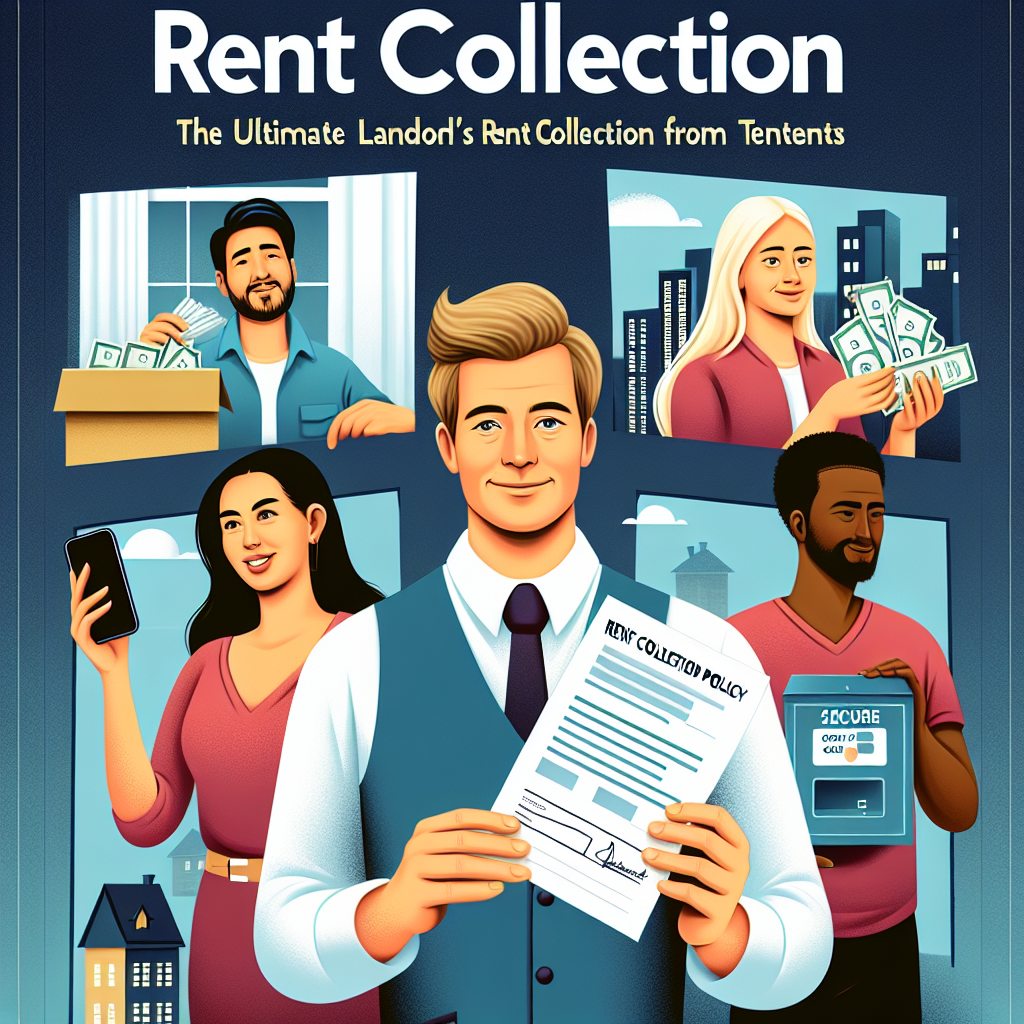-
Table of Contents
- The Ultimate Landlord’s Guide to Efficient Rent Collection from Tenants
- Understanding the Importance of Efficient Rent Collection
- Setting Clear Rent Collection Policies
- Implementing Online Rent Collection Systems
- Offering Multiple Payment Options
- Automating Rent Reminders and Notifications
- Enforcing Late Fees and Penalties
- Building Strong Landlord-Tenant Relationships
- Handling Late Payments and Delinquencies
- Utilizing Property Management Software
- Conclusion
The Ultimate Landlord’s Guide to Efficient Rent Collection from Tenants

Rent collection is a critical aspect of property management that can significantly impact a landlord’s cash flow and overall financial health. Efficient rent collection ensures that landlords can meet their financial obligations, maintain their properties, and provide quality service to their tenants. This guide will provide landlords with comprehensive strategies and best practices for efficient rent collection, supported by relevant examples, case studies, and statistics.
Understanding the Importance of Efficient Rent Collection
Efficient rent collection is not just about receiving payments on time; it also involves minimizing disputes, reducing administrative burdens, and maintaining positive landlord-tenant relationships. Here are some key reasons why efficient rent collection is crucial:
- Cash Flow Management: Timely rent payments ensure a steady cash flow, allowing landlords to cover mortgage payments, property maintenance, and other expenses.
- Tenant Retention: A streamlined rent collection process can enhance tenant satisfaction and reduce turnover rates.
- Legal Compliance: Proper documentation and adherence to rent collection laws can protect landlords from legal disputes.
- Operational Efficiency: Automating rent collection can save time and reduce administrative tasks.
Setting Clear Rent Collection Policies
Establishing clear and transparent rent collection policies is the foundation of efficient rent collection. These policies should be communicated to tenants at the beginning of the lease agreement and reinforced periodically. Key elements of a rent collection policy include:
- Due Date: Specify the exact date when rent is due each month.
- Grace Period: Define any grace period allowed for late payments and the consequences of missing this period.
- Late Fees: Outline the late fee structure and how it will be applied.
- Payment Methods: List the acceptable payment methods (e.g., online payments, checks, direct deposit).
- Communication Channels: Provide contact information for rent-related inquiries and issues.
Implementing Online Rent Collection Systems
In today’s digital age, online rent collection systems offer numerous advantages over traditional methods. These systems can streamline the rent collection process, reduce errors, and provide convenience for both landlords and tenants. Some popular online rent collection platforms include:
- PayRent: A user-friendly platform that allows tenants to pay rent online and landlords to track payments in real-time.
- Buildium: A comprehensive property management software that includes online rent collection, accounting, and tenant communication tools.
- AppFolio: A cloud-based property management solution that offers online rent payments, maintenance requests, and lease management.
Case Study: A property management company in New York implemented an online rent collection system and reported a 30% reduction in late payments within the first six months. Tenants appreciated the convenience of online payments, and the company saved significant time on administrative tasks.
Offering Multiple Payment Options
Providing tenants with multiple payment options can increase the likelihood of timely rent payments. Some common payment methods include:
- Online Payments: Tenants can pay rent through online portals using credit/debit cards or bank transfers.
- Direct Deposit: Tenants can set up automatic bank transfers to ensure timely payments.
- Checks: While less common, some tenants may prefer to pay rent by check.
- Mobile Payment Apps: Apps like Venmo, PayPal, and Zelle offer convenient payment options for tech-savvy tenants.
Example: A landlord in California offered tenants the option to pay rent via a mobile payment app. This flexibility led to a 15% increase in on-time payments, as tenants found it easier to make payments on the go.
Automating Rent Reminders and Notifications
Automated rent reminders and notifications can significantly reduce the incidence of late payments. These reminders can be sent via email, SMS, or through property management software. Key benefits of automated reminders include:
- Timely Notifications: Tenants receive reminders before the rent due date, reducing the likelihood of forgetfulness.
- Consistency: Automated reminders ensure that all tenants receive consistent communication.
- Reduced Administrative Burden: Landlords save time by not having to manually send reminders.
Case Study: A landlord in Texas implemented an automated reminder system and saw a 20% decrease in late payments within three months. Tenants appreciated the reminders, and the landlord experienced fewer payment-related issues.
Enforcing Late Fees and Penalties
While it’s important to be understanding of tenants’ financial situations, enforcing late fees and penalties can encourage timely rent payments. Late fees should be clearly outlined in the lease agreement and consistently applied. Consider the following best practices:
- Reasonable Fees: Set late fees that are reasonable and in compliance with local laws.
- Consistent Enforcement: Apply late fees consistently to all tenants to avoid claims of favoritism or discrimination.
- Communication: Clearly communicate the late fee policy to tenants and provide reminders if necessary.
Example: A landlord in Florida implemented a late fee policy that charged tenants a $50 fee for payments received after the 5th of the month. This policy led to a significant reduction in late payments, as tenants were motivated to avoid the additional cost.
Building Strong Landlord-Tenant Relationships
Positive landlord-tenant relationships can contribute to efficient rent collection. When tenants feel respected and valued, they are more likely to prioritize timely rent payments. Strategies for building strong relationships include:
- Open Communication: Maintain open lines of communication and be responsive to tenant inquiries and concerns.
- Fair Treatment: Treat all tenants fairly and consistently, adhering to the terms of the lease agreement.
- Proactive Maintenance: Address maintenance issues promptly to demonstrate your commitment to tenant satisfaction.
- Regular Check-Ins: Conduct regular check-ins to ensure tenants are satisfied with their living conditions.
Case Study: A landlord in Ohio prioritized building strong relationships with tenants by conducting quarterly check-ins and promptly addressing maintenance requests. As a result, the landlord experienced a 95% on-time rent payment rate and high tenant retention.
Handling Late Payments and Delinquencies
Despite best efforts, some tenants may still struggle with late payments or delinquencies. It’s important to handle these situations professionally and legally. Steps to address late payments include:
- Initial Reminder: Send a polite reminder to the tenant shortly after the rent due date.
- Follow-Up Communication: If the payment is still not received, follow up with a more formal communication outlining the consequences of non-payment.
- Payment Plans: Consider offering a payment plan for tenants facing temporary financial difficulties.
- Legal Action: If all else fails, be prepared to take legal action, such as filing for eviction, in accordance with local laws.
Example: A landlord in Illinois had a tenant who consistently paid rent late. After several reminders and discussions, the landlord offered a payment plan that allowed the tenant to catch up on missed payments over three months. This approach resolved the issue without resorting to eviction.
Utilizing Property Management Software
Property management software can be a valuable tool for landlords looking to streamline rent collection and other property management tasks. These software solutions offer features such as:
- Automated Rent Collection: Set up automatic rent payments and reminders.
- Tenant Communication: Communicate with tenants through integrated messaging systems.
- Maintenance Tracking: Manage maintenance requests and track work orders.
- Financial Reporting: Generate financial reports to track income and expenses.
Case Study: A property management company in Colorado implemented property management software and reported a 40% increase in operational efficiency. The software’s automated rent collection and maintenance tracking features saved time and reduced errors.
Conclusion
Efficient rent collection is essential for maintaining a healthy cash flow, reducing administrative burdens, and fostering positive landlord-tenant relationships. By setting clear rent collection policies, implementing online payment systems, offering multiple payment options, automating reminders, enforcing late fees, building strong relationships, handling late payments professionally, and utilizing property management software, landlords can significantly improve their rent collection processes.
In summary, the key takeaways for efficient rent collection are:
- Establish clear and transparent rent collection policies.
- Implement online rent collection systems for convenience and efficiency.
- Offer multiple payment options to accommodate tenant preferences.
- Automate rent reminders and notifications to reduce late payments.
- Enforce late fees consistently to encourage timely payments.
- Build strong landlord-tenant relationships to enhance tenant satisfaction.
- Handle late payments and delinquencies professionally and legally.
- Utilize property management software to streamline operations.
By following these strategies, landlords can achieve efficient rent collection, ensuring financial stability and long-term success in property management.








